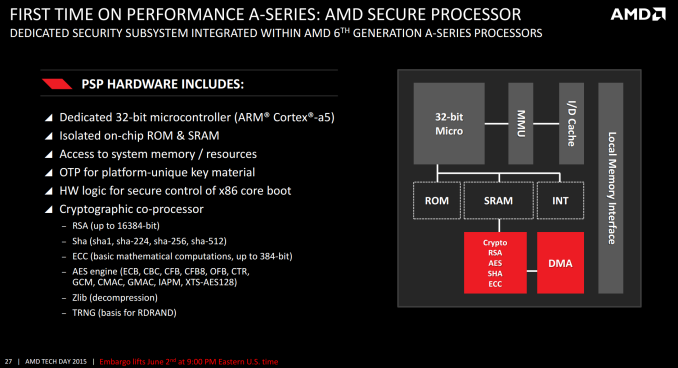AMD Launches Carrizo: The Laptop Leap of Efficiency and Architecture Updates
by Ian Cutress on June 2, 2015 9:00 PM ESTAMD Secure Processor
One of the final pieces in the puzzle is AMD’s Secure Processor, which they seemed to have called the PSP. The concept of the security processor has evolved over time, but the premise of a locked down area to perform sensitive work that is both hidden and cryptographically sealed appeals to a particular element of the population, particularly when it comes to business.
AMD’s PSP is based around a single 32-bit ARM Cortex-A5, with its own isolated ROM and SRAM but has access to system memory and resources. It contains logic to deal with the x86 POST process but also features a cryptographic co-processor.
ARM has been promoting TrustZone for a couple of years now, and AMD has been tinkering with their Secure Processor proposition for almost as long although relatively few explanations from AMD outside ‘it is there’ have come forward.
Final Thoughts
Sometimes a name can inspire change. Carrizo isn’t one of those names, and when hearing the words ‘AMD’s notebook processor’, those words have not instilled much hope in the past, much to AMD’s chagrin no doubt. Despite this, we come away from Carrizo with a significantly positive impression because this feels more than just another Bulldozer-based update.
If you can say in a sentence ‘more performance, less power and less die area’, it almost sounds like a holy trifecta of goals a processor designer can only hope to accomplish. Normally a processor engineer is all about performance, so it takes an adjustment in thinking to focus more so on power, but AMD is promising this with Carrizo. Part of this will be down to the effectiveness of the high density libraries (which according to the slides should also mean less power or more performance for less die area) but also the implementation of the higher bandwidth encoder, new video playback pathway and optimization of power through the frequency planes. Doubling the L1 data cache for no loss in latency will have definite impacts to IPC, as well as the better prefetch and branch prediction.
Technically, on paper, all the blocks in play look exciting and every little margin can help AMD build a better APU. It merely requires validation of the results we have been presented along with a killer device to go along with it, something which AMD has lacked in the past and reviewers have had trouble getting their hands on. We are in discussions with AMD to get the sufficient tools to test independently a number of the claims, and to see if AMD’s Carrizo has potential.











137 Comments
View All Comments
Cloakstar - Wednesday, June 3, 2015 - link
These scores definitely need validation. If true, Carrizo is a massive win.The FX 8800P graphic shows a 3DMark 11 score of nearly 2000 at 15W, and 2700+ at 35W.
The A10-7850k has a score of 2403 at 95W.
http://www.anandtech.com/show/7677/amd-kaveri-revi...
azazel1024 - Wednesday, June 3, 2015 - link
I didn't realize AMD's processors were so terrible at video playback. My 2 year old (pushing 3 now) Ivy Bridge i5-3317u equipped HP Envy 4t can manage roughly 6hrs of video playback of a 1080p h.264 12Mbps source and it only has about a 45whr battery in it. With a higher TDP chip and lots of "not power saving" features.creed3020 - Wednesday, June 3, 2015 - link
I am definitely in the market for one of these laptops to replace two older laptops in the house with one new one. If it had Carrizo for the hear I would be mighty happy to support AMD over Intel for this round, as the improvements here sound very much adequate for the system I am looking for.The ideal system would be something like the HP Spectre x360 for around $750.
michal1980 - Wednesday, June 3, 2015 - link
AMDs problem start with the 1st slide. "more people by notebooks priced between $400 and 700 than at any other price. Almost 2 out of every 5 notbooks sold is in that segment."umm, 3 out of 5 notebooks is sold outside of the 400-700 dollar price. Thats greater then 2 out of 5.
AMD fails math. Fails in general.
silverblue - Wednesday, June 3, 2015 - link
No. 3 out of 5 notebooks are either sold below $400, or above $700, and out of those two disparate segments, neither is as large as the $400 - $700 segment.There isn't a "math" fail here.
takeship - Wednesday, June 3, 2015 - link
The bigger issue is that AMD is admitting they are so uncompetitive in the market that it doesn't make business sense to chase at least 60% of consumers (and ignoring business costumers completely). And realistically, that 400-700 market is really more like a 550-700 market, as 400-500 is close enough to base iPad Air 2/premium Android tab pricing that you lose a lot of sales that direction.silverblue - Wednesday, June 3, 2015 - link
Surely TrustZone is a sign that they want business customers? Additionally, being able to work on the battery all day is a good thing.Gigaplex - Thursday, June 4, 2015 - link
Read closer. Their "all day battery" claim is being able to idle for 8 hours. You won't get a full work day out of that.silverblue - Friday, June 5, 2015 - link
If you class H264 1080p video as idle, sure. My fault for saying "work" though, however if all you're doing is light stuff, you won't be far off.FlushedBubblyJock - Wednesday, June 10, 2015 - link
for amd's sake we'll class idle as full screen video playback and 1.5 hours as all day, and no wifi bluetooth or dvd player active as full multimedia active -there, now look, you were correct ! your ego is in tact, you're never wrong
Calgon take me away